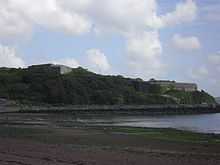Fort Hubberstone

Fort Hubberstone, on the west side of Milford Haven, Pembrokeshire, is a Grade II* Listed Building[1] which belongs to a series of forts built as part of the inner line of defence of the Haven following the Royal Commission on the Defence of the United Kingdom. Together with Popton Fort on the opposite shore, it provided an interlocking field of fire, and represented the last layer of defence before reaching the Royal Naval dockyard at Pembroke Dock. Construction began in 1863 and was completed in 1865 at a cost of £55,000.[2] It is a large battery, with eleven guns in casemates, eight in an open battery above, with another nine in an open flank battery, and a large barracks to the rear. It is a D-shaped structure, with a bomb-proof roof which protected the barracks and other buildings from mortar projectiles. On its landward side, it was protected by a deep ditch, and on the seaward side by a counter-scarp gallery.[3] The associated casement battery is located further down the headland and separated from the fort.[3]
The barracks had capacity for 250 men, sourced from the Royal Pembrokeshire Artillery and the 24th Regt of Foot. Recruitment however was frequently constrained by the isolation of the fort, lacking the appeal of more urban stations.[2] The fort was often required to fire live practice rounds, and in 1894 participated in experiments to illuminate targets with searchlights so they could be engaged at night. Notoriously, in 1875 Lt Walter of the militia was murdered by a Doctor Alder in a drunken brawl.[2]
The fort was abandoned after World War I as a consequence of the Haldane Reforms. A 1919 proposal to convert the structure into social housing came to nothing.[2] World War II saw the fort once again in active use, when it was used as an air raid shelter and army camp for American military personnel.[4]
On a good site, the fort has fallen into disrepair. The current owners had plans to restore the structure, but these have fallen through. Owned by Milford Haven Port Authority, the site is not currently open to the public, and has been the scene of non-fatal injuries to trespassers.[5] In 2011 it was named as the fifth most endangered archaeological site in the UK by British Archaeology,[6][7] which prompted a campaign to seek a long term sustainable use of the site.[8][9]
This place is often spelled 'Hubberston Fort' like the area of Milford Haven that it is located in.
References
- ↑ Fort Hubberston, Milford www.BritishListedBuildings.co.uk, accessed 01.06.11
- ↑ 2.0 2.1 2.2 2.3 Genealogy World - Fort Hubberstone Mason, Graham, Retrieved 25 December 2013
- ↑ 3.0 3.1 Phillips, Benjamin A, Pembrokeshire's Forts and Military Airfields, Logaston Press, 2013. ISBN 9781906663735
- ↑ Experience Pembrokeshire - Hubberstone Fort "Experience Pembrokeshire Website", accessed 14.11.09
- ↑ Safety Plea After Fort Fall Drama Milford Mercury Article, 18 August 2005
- ↑ Hubberstone Fort is one of Britain’s most endangered archaeological sites Article, www.WalesOnline.co.uk, 26 April 2011
- ↑ 6 Threatened Sites British Archaeology Magazine Article, www.britarch.ac.uk, accessed 30 June 2011
- ↑ Online Campaign To Save Hubberston Fort Gathers Pace Article, www.MilfordMercury.co.uk, 13 May 2011
- ↑ 1,500 Join Battle To Save Hubberston Fort Article, www.MilfordMercury.co.uk, 30 June 2011
External links
Coordinates: 51°42′30″N 5°03′17″W / 51.70833°N 5.05472°W